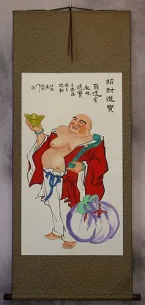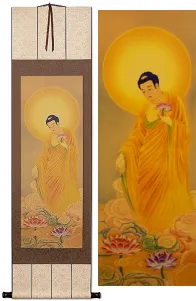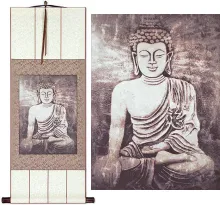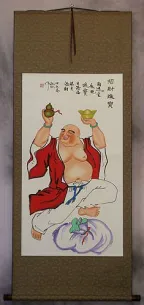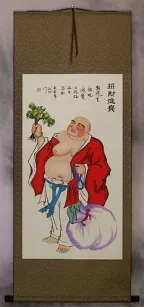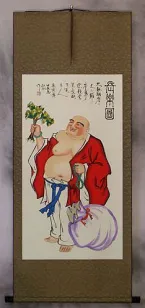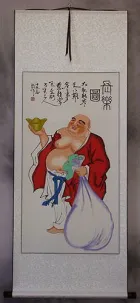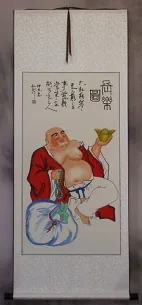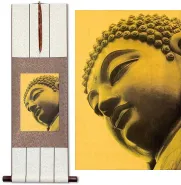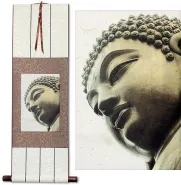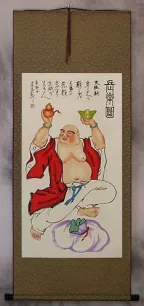Many custom options...
And formats...

The name Buddha Eye in Chinese / Japanese...
Buy a Buddha Eye calligraphy wall scroll here!
The Eye of the Buddha
This in-stock artwork might be what you are looking for, and ships right away...
Gallery Price: $200.00
Your Price: $69.88
Gallery Price: $200.00
Your Price: $69.88
Gallery Price: $200.00
Your Price: $69.88
Not the results for buddha eye that you were looking for?
Below are some entries from our dictionary that may match your buddha eye search...
| Characters If shown, 2nd row is Simp. Chinese |
Pronunciation Romanization |
Simple Dictionary Definition |
明 see styles |
míng ming2 ming mei / me めい |
More info & calligraphy: Light / Bright(1) (ant: 暗) brightness; (2) discernment; insight; an eye (for); (3) (See 明を失う) eyesight; vision; (prefix) (4) (abbreviation) (See 明治) nth year in the Meiji era (1868.9.8-1912.7.30); (surname) Meishuu vidyā, knowledge. ming means bright, clear, enlightenment, intp. by 智慧 or 聰明 wisdom, wise; to understand. It represents Buddha-wisdom and its revelation; also the manifestation of a Buddha's light or effulgence; it is a term for 眞言 because the 'true word' can destroy the obscurity of illusion; the 'manifestation' of the power of the object of worship; it means also dhāraṇīs or mantras of mystic wisdom. Also, the Ming dynasty A. D. 1368-1644. |
佛眼 see styles |
fó yǎn fo2 yan3 fo yen butsugen |
More info & calligraphy: The Eye of the Buddha |
三力 see styles |
sān lì san1 li4 san li sanriki |
The three powers, of which there are various groups: (1) (a) personal power; (6) tathāgata-power; (c) power of the Buddha-nature within. (2) (a) power of a wise eye to see the Buddha-medicine (for evil); (b) of diagnosis of the ailment; (c) of suiting and applying the medicine to the disease. (3) (a) the power of Buddha; (b) of samādhi; (c) of personal achievement or merit. |
五眼 see styles |
wǔ yǎn wu3 yan3 wu yen gogen ごげん |
{Buddh} the five eyes (physical eye, heavenly eye, wisdom eye, dharma eye and Buddha eye) The five kinds of eyes or vision: human; deva (attainable by men in dhyāna); Hīnayāna wisdom; bodhisattva truth; and Buddha-vision or omniscience. There are five more relate to omniscience making 十眼 ten kinds of eyes or vision. |
仏眼 see styles |
butsugen ぶつげん |
{Buddh} (See 五眼) the Buddha eye |
大日 see styles |
dà rì da4 ri4 ta jih dainichi だいにち |
Mahavairocana (Tathagata); Great Sun; Supreme Buddha of Sino-Japanese esoteric Buddhism; (place-name, surname) Dainichi Vairocana, or Mahāvairocana 大日如來; 遍照如來; 摩訶毘盧遮那; 毘盧遮那; 大日覺王 The sun, "shining everywhere" The chief object of worship of the Shingon sect in Japan, "represented by the gigantic image in the temple at Nara." (Eliot.) There he is known as Dai-nichi-nyorai. He is counted as the first, and according to some, the origin of the five celestial Buddhas (dhyāni-buddhas, or jinas). He dwells quiescent in Arūpa-dhātu, the Heaven beyond form, and is the essence of wisdom (bodhi) and of absolute purity. Samantabhadra 普賢 is his dhyāni-bodhisattva. The 大日經 "teaches that Vairocana is the whole world, which is divided into Garbhadhātu (material) and Vajradhātu (indestructible), the two together forming Dharmadhātu. The manifestations of Vairocana's body to himself―that is, Buddhas and Bodhisattvas ―are represented symbolically by diagrams of several circles ". Eliot. In the 金剛界 or vajradhātu maṇḍala he is the center of the five groups. In the 胎藏界 or Garbhadhātu he is the center of the eight-leaf (lotus) court. His appearance, symbols, esoteric word, differ according to the two above distinctions. Generally he is considered as an embodiment of the Truth 法, both in the sense of dharmakāya 法身 and dharmaratna 法寳. Some hold Vairocana to be the dharmakāya of Śākyamuni 大日與釋迦同一佛 but the esoteric school denies this identity. Also known as 最高顯廣眼藏如來, the Tathagata who, in the highest, reveals the far-reaching treasure of his eye, i.e. the sun. 大日大聖不動明王 is described as one of his transformations. Also, a śramaņa of Kashmir (contemporary of Padma-saṃbhava); he is credited with introducing Buddhism into Khotan and being an incarnation of Mañjuśrī; the king Vijaya Saṃbhava built a monastery for him. |
實眼 实眼 see styles |
shí yǎn shi2 yan3 shih yen jitsugen |
An eye able to discern reality, i.e. the Buddha-eye. |
愛眼 爱眼 see styles |
ài yǎn ai4 yan3 ai yen aigen |
The eye of love, that of Buddha. |
慈眼 see styles |
cí yǎn ci2 yan3 tz`u yen tzu yen jigen; jigan じげん; じがん |
{Buddh} merciful eye (of a Buddha or a bodhisattva watching humanity); (surname) Jigan The compassionate eye (of Buddha). |
斫芻 斫刍 see styles |
zhuó chú zhuo2 chu2 cho ch`u cho chu shashu |
(斫乞芻) cakṣu (s), the eye, one of the six organs of sense. Cakṣurdhātu is the 眼界 eye-realm, or sight-faculty. There are definitions such as the eye of body, mind, wisdom, Buddha-truth, Buddha; or human, deva, bodhisattva, dharma, and Buddha vision. |
神通 see styles |
shén tōng shen2 tong1 shen t`ung shen tung jinzuu / jinzu じんづう |
remarkable ability; magical power (place-name) Jinzuu (神通力) Ubiquitous supernatural power, especially of a Buddha, his ten powers including power to shake the earth, to issue light from his pores, extend his tongue to the Brahma-heavens effulgent with light, cause divine flowers, etc., to rain from the sky, be omnipresent, and other powers. Supernatural powers of eye, ear, body, mind, etc. |
蓮眼 莲眼 see styles |
lián yǎn lian2 yan3 lien yen rengen |
The eye of the blue lotus, i.e. the wonderful eye of Buddha. |
道目 see styles |
dào mù dao4 mu4 tao mu doume / dome どうめ |
(place-name) Dōme the eye for the (Buddha-)Path |
道眼 see styles |
dào yǎn dao4 yan3 tao yen dōgen |
The eye attained through the cultivation of Buddha-truth; the eye which sees that truth. |
達磨 达磨 see styles |
dá mó da2 mo2 ta mo daruma(p); daruma だるま(P); ダルマ |
(1) (kana only) daruma; tumbling doll; round, red-painted good-luck doll in the shape of Bodhidharma, with a blank eye to be completed when a person's wish is granted; (2) (kana only) Bodhidharma; (3) prostitute; (personal name) Daruma dharma; also 達摩; 達麼; 達而麻耶; 曇摩; 馱摩 tr. by 法. dharma is from dhara, holding, bearing, possessing, etc.; and means 'that which is to be held fast or kept, ordinance, statute, law, usage, practice'; 'anything right.' M.W. It may be variously intp. as (1) characteristic, attribute, predicate; (2) the bearer, the transcendent substratum of single elements of conscious life; (3) element, i.e. a part of conscious life; (4) nirvāṇa, i.e. the Dharma par excellence, the object of Buddhist teaching; (5) the absolute, the real; (6) the teaching or religion of Buddha; (7) thing, object, appearance. Also, Damo, or Bodhidharma, the twenty-eighth Indian and first Chinese patriarch, who arrived in China A.D. 520, the reputed founder of the Chan or Intuitional School in China. He is described as son of a king in southern India; originally called Bodhitara. He arrived at Guangdong, bringing it is said the sacred begging-bowl, and settled in Luoyang, where he engaged in silent meditation for nine years, whence he received the title of wall-gazing Brahman 壁觀婆羅門, though he was a kṣatriya. His doctrine and practice were those of the 'inner light', independent of the written word, but to 慧可 Huike, his successor, he commended the Laṅkāvatāra-sūtra as nearest to his views. There are many names with Dharma as initial: Dharmapāla, Dharmagupta, Dharmayaśas, Dharmaruci, Dharmarakṣa, Dharmatrāta, Dharmavardhana, etc. |
開眼 开眼 see styles |
kāi yǎn kai1 yan3 k`ai yen kai yen kaigan; kaigen かいがん; かいげん |
to open one's eyes; to widen one's horizons (n,vs,vi) (1) (esp. かいげん) enlightenment; spiritual awakening; opening one's eyes to the truth; (n,vs,vi) (2) (esp. かいげん) reaching one's peak (as a performer, etc.); reaching the highest echelons; (n,vs,vi,vt) (3) (かいがん only) gaining eyesight; restoring eyesight; opening the eyes; (n,vs,vi) (4) (かいげん only) {Buddh} filling out the eyes (of a Buddha) as the last step of consecrating a new statue or picture; ceremony where a newly made image or idol is consecrated opening the eye |
三界眼 see styles |
sān jiè yǎn san1 jie4 yan3 san chieh yen sangai gen |
The trailokya eye, i.e. Buddha, who sees all the realms and the way of universal escape. |
世間眼 世间眼 see styles |
shì jiān yǎn shi4 jian1 yan3 shih chien yen seken gen |
The Eye of the world, the eye that sees for all men, i. e. the Buddha, who is also the one that opens the eyes of men. Worldly, or ordinary eyes. Also 世眼. |
佛眼尊 see styles |
fó yǎn zūn fo2 yan3 zun1 fo yen tsun Butsugen son |
A term of the esoteric cult for the source or mother of all wisdom, also called佛眼部母; 佛眼佛母; 佛母身; 佛母尊; 虛空佛. |
天眼力 see styles |
tiān yǎn lì tian1 yan3 li4 t`ien yen li tien yen li tengen riki |
The power of the celestial or deva eye, one of the ten powers of a Buddha. |
胎藏界 see styles |
tāi zàng jiè tai1 zang4 jie4 t`ai tsang chieh tai tsang chieh taizō kai |
Garbhadhātu, or Garbhakośa-(dhātu), the womb treasury, the universal source from which all things are produced; the matrix; the embryo; likened to a womb in which all of a child is conceived— its body, mind, etc. It is container and content; it covers and nourishes; and is the source of all supply. It represents the 理性 fundamental nature, both material elements and pure bodhi, or wisdom in essence or purity; 理 being the garbhadhātu as fundamental wisdom, and 智 acquired wisdom or knowledge, the vajradhātu. It also represents the human heart in its innocence or pristine purity, which is considered as the source of all Buddha-pity and moral knowledge. And it indicates that from the central being in the maṇḍala, viz. the Sun as symbol of Vairocana, there issue all the other manifestations of wisdom and power, Buddhas, bodhisattvas, demons, etc. It is 本覺 original intellect, or the static intellectuality, in contrast with 始覺 intellection, the initial or dynamic intellectuality represented in the vajradhātu; hence it is the 因 cause and vajradhātu the 果 effect; though as both are a unity, the reverse may be the rule, the effect being also the cause; it is also likened to 利他 enriching others, as vajradhātu is to 自利 enriching self. Kōbō Daishi, founder of the Yoga or Shingon 眞言 School in Japan, adopted the representation of the ideas in maṇḍalas, or diagrams, as the best way of revealing the mystic doctrine to the ignorant. The garbhadhātu is the womb or treasury of all things, the universe; the 理 fundamental principle, the source; its symbols are a triangle on its base, and an open lotus as representing the sun and Vairocana. In Japan this maṇḍala is placed on the east, typifying the rising sun as source, or 理. The vajradhātu is placed west and represents 智 wisdom or knowledge as derived from 理 the underlying principle, but the two are essential one to the other, neither existing apart. The material and spiritual; wisdom-source and intelligence; essence and substance; and similar complementary ideas are thus portrayed; the garbhadhātu may be generally considered as the static and the vajradhātu as the dynamic categories, which are nevertheless a unity. The garbhadhātu is divided into 三部 three sections representing samādhi or quiescence, wisdom-store, and pity-store, or thought, knowledge, pity; one is called the Buddha-section, the others the Vajra and Lotus sections respectively; the three also typify vimokṣa, prajñā, and dharmakāya, or freedom, understanding, and spirituality. There are three heads of these sections, i. e. Vairocana, Vajrapāṇi, and Avalokiteśvara; each has a mother or source, e. g. Vairocana from Buddha's-eye; and each has a 明王 or emanation of protection against evil; also a śakti or female energy; a germ-letter, etc. The diagram of five Buddhas contains also four bodhisattvas, making nine in all, and there are altogether thirteen 大院 or great courts of various types of ideas, of varying numbers, generally spoken of as 414. Cf. 金剛界; 大日; 兩部. |
一眼之龜 一眼之龟 see styles |
yī yǎn zhī guī yi1 yan3 zhi1 gui1 i yen chih kuei ichigen no kame |
A sea turtle with only one eye, and that underneath, entered a hollow in a floating log; the log, tossed by the waves, happened to roll over, whereupon the turtle momentarily saw the sun and moon; an illustration of the rareness of the appearance of a Buddha; also of the difficulty of being reborn as a man. |
佛眼佛母 see styles |
fó yǎn fó mǔ fo2 yan3 fo2 mu3 fo yen fo mu butsu gen butsu mo |
goddess of the Buddha's eye |
佛眼部母 see styles |
fó yǎn bù mǔ fo2 yan3 bu4 mu3 fo yen pu mu Butsugen bumo |
goddess of the Buddha's eye |
六根淸淨 六根淸净 see styles |
liù gēn qīng jìng liu4 gen1 qing1 jing4 liu ken ch`ing ching liu ken ching ching rokkon shōjō |
The six organs and their purification in order to develop their unlimited power and interchange, as in the case of a Buddha. This full development enables e. g. the eye to see everything in a great chiliocosm from its highest heaven down to its lowest hells and all the beings past, present, and future, with all the karma of each. |
十二火天 see styles |
shí èr huǒ tiān shi2 er4 huo3 tian1 shih erh huo t`ien shih erh huo tien jūnikaten |
The homa-, or fire-spirits; Whose representations, colours, magic words, signs, symbols, and mode of worship are given in the 大日經疏20. Also 十二火尊; 十二種火法. The twelve fire-spirits are: (1) Indra or Vairocana, the discoverer or source of fire, symbolizing 智 knowledge; (2) the moon 行滿 which progresses to fullness, with mercy as root and enlightenment as fruit, i,e. Buddha; (3) the wind, represented as a half-moon, fanner of fame, of zeal, and by driving away dark clouds, of enlightenment; (4) the red rays of the rising sun, rohitaka, his swords (or rays) indicating 議 wisdom; (5) 沒M004101拏 a form half stern, half smiling, sternly driving away the passions and trials; (6) 忿怒 irate, bellowing with open mouth, showing four teeth, flowing locks, one eye closed; (7) 闍吒羅 fire burning within, i.e. the inner witness, or realization; (8) 迄灑耶 the waster, or destroyer of waste and injurious products within, i.e. inner purification; (9) 意生 the producer at will, capable of all variety, resembling Viśvakarman, the Brahmanic Vulcan; (10) 羯羅微 the fire-eater; (11) untraceable; (12) 謨賀那 the completer, also the subduer of demons. |
波羅夷四喩 波罗夷四喩 see styles |
bō luó yí sì yú bo1 luo2 yi2 si4 yu2 po lo i ssu yü harai shiyu |
The four metaphors addressed by the Buddha to monks are: he who breaks the vow of chastity is as a needle without an eye, a dead man, a broken stone which cannot be united, a tree cut in two which cannot live. |
眉間白毫相 眉间白毫相 see styles |
méi jiān bái háo xiàng mei2 jian1 bai2 hao2 xiang4 mei chien pai hao hsiang miken byakugō sō |
ūrṇā. The curl of white hairs, between the eyebrows of the Buddha, one of the thirty-two signs of Buddhahood. |
The following table may be helpful for those studying Chinese or Japanese...
| Title | Characters | Romaji (Romanized Japanese) | Various forms of Romanized Chinese | |
| The Eye of the Buddha | 佛眼 佛眼 / 仏眼 | butsugen / butsugen | wǔ yǎn / wu3 yan3 / wu yan / wuyan | wu yen / wuyen |
| In some entries above you will see that characters have different versions above and below a line. In these cases, the characters above the line are Traditional Chinese, while the ones below are Simplified Chinese. | ||||
Successful Chinese Character and Japanese Kanji calligraphy searches within the last few hours...

